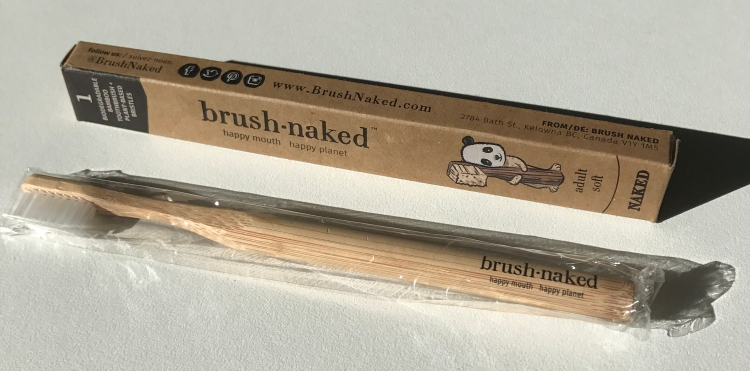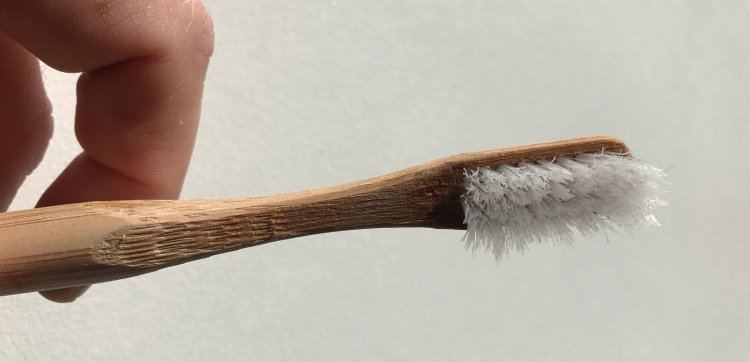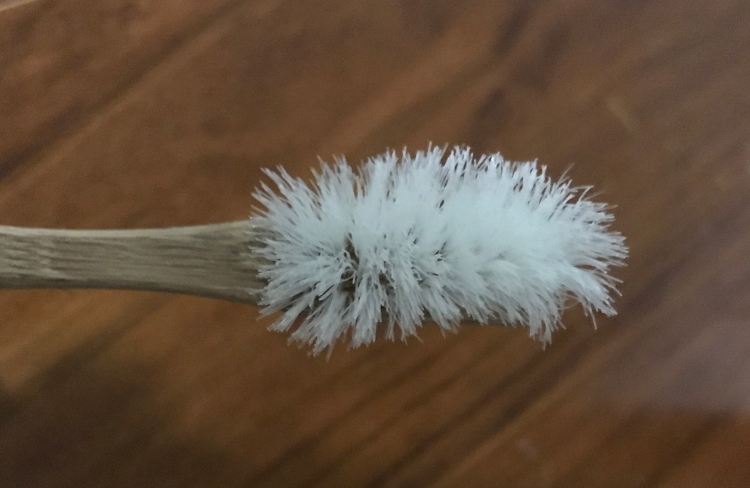A friend recently shared with me a Facebook post about Brush Naked biodegradable bamboo toothbrushes with plant-based bristles. My first thought was ‘not another bamboo toothbrush trying to pass as 100% biodegradable’ but after closer inspection, I found it to be the real deal!
The difference with this toothbrush (which is a Canadian brand, made in China) is that the bristles are made from tapioca and corn, and are compostable. They’re not a variation of Nylon like the other toothbrushes I’ve seen.
For those of you in Australia, it’s available exclusively online at Flora & Fauna. If you live elsewhere in the world you can visit the Brush Naked website to find them.
Flora & Fauna said they had seen the testing and lab results to prove it is compostable, and that it’s a material used for other biodegradable applications but hasn’t been used for toothbrush bristles before. They also provided a very honest review for the product, which is great:
“Now we must warn you that they don’t last nearly as along as nylon bristles so if you want a toothbrush that lasts 6 weeks+, get one with nylon bristles. These bristles fray quickly; we can get them to last from a few days to a couple of weeks (we’ve done a fair bit of testing) but some people have made them last longer.”
Because my current toothbrushes last months longer than they are supposed too, I decided to buy one and give it ago. I figured I would be in the category of people who could make it last longer than a couple of weeks.
It wasn’t a cheap toothbrush – $7.95 compared to mine which are $3 to $4 depending on where I source them and how many I buy at a time. But, I was keeping an open mind, willing to support environmental innovation, and, businesses have to start somewhere before they can become more economical.

I was a little surprised when I opened the toothbrush box to find another layer of packaging (The Environmental Toothbrush doesn’t have this). I emailed Brush Naked to find out what the material was and got this response:
“The sleeves are a 100% biodegradable/compostable cello made from wood and cotton pulp. We actually didn’t wrap them in the cello until we started wholesaling them. You’d be shocked to see how many people actually take the toothbrush out of the box to feel the bristles. We felt we had to do something to keep them sanitary! It is going in your mouth after all.”
I guess this makes some people happy but I really have no problem with my other toothbrushes not being wrapped. Especially as I buy a 12 month supply for the family at one time, straight from the supplier; there’s no opportunity for anyone else to open the boxes and feel the bristles.

Unfortunately, after looking and feeling magnificent to begin with, my toothbrush frayed after one brush.

By the time I had brushed my teeth four times (two days) it was too uncomfortable to use because the bristles had became harder and more frayed.

Time to compost the bristles and save the handle for use in my garden.
In my emails to the company, I had also asked if they had certification on the compostability of the bristles and if they knew how long it would take to break down. The answer was:
“We do not have certification. We really hesitate giving timelines for compostability as it will completely depend on the compost. It DOES require a compost that is generating heat, so if the compost is really small, it will take significantly longer than a large compost.”
My first thought was that I can’t compost this toothbrush because I don’t have a hot composting system at home (I use other methods), nor can I access a commercial composting system through council organic waste collection.
But, after asking the company for information on the eco friendliness of the process of turning tapioca and corn into a bristle, I received this information:
“Compared to fossil-fuel based plastics, it definitely is [environmentally friendly]. So are any dyes added to our bristles. I’ll attach an article that explains the process pretty well. It’s about a different industry, but it breaks it down pretty well.
Article: SELFECO BREAKS DOWN PLA: MAKING 3D PRINTING ECO-FRIENDLY“
This led me to realise that the actual material used for the bristles is Polylactic acid or PLA and I ended up perusing a range of articles to learn more about PLA. I came across this:
“Not all PLA plastic packaging will find its way to a composting facility. However, it’s reassuring to know that when corn-based plastics are incinerated they do not emit toxic fumes like PET or other petroleum-based plastics.” (Source 8 Things You Need To Know About PLA Plastic)
So I started putting the bristles in my open fireplace (it’s Winter here). The ash will be spread on my garden at a later time.
But then I stopped and decided to do an experiment with the remaining bristles. I’m going to stick my toothbrush in the ground and check on it over the months to see what happens.
I think it’s fantastic that someone has made progress in producing compostable toothbrush bristles and hopefully they are continuing to innovate so that the bristles have a much longer life. Maybe one day that could include changeable heads, rather than having to replace whole toothbrushes, to reduce the environmental impact even further. For now, with the short lifespan and increased cost, I can’t justify switching to this brush. What are your thoughts?
P.S. Have you heard of the burn test? Some people think that burning the bristles to see if it melts or burns is an indication of biodegradability, with those that melt being plastic and those that burn being biodegradable. Did you notice how these bristles melted rather than burned? That’s actually a feature of this biodegradable bioplastic, or PLA. So, it seems the burn test is not really a good indicator of biodegradability.
Further reading:
Everything You Need To Know About Polylactic Acid (PLA)

Thank you. How exciting. I guess it would be hard with something that is supposed to breakdown in warm, wet environments to then go into you mouth. However, i wonder what was used 100 years ago? I might google that.
Like you, i couldnt spend $8 every few days
LikeLiked by 1 person
Let me know what you find out!
LikeLike
They used hog hair right up until nylon came along. I doubt we’ll see hog hair making a comeback? I wonder if the natural bristles used on eco-friendly dish brushes are suitable solution or if they are too hard? Just thinking out loud here. I’m sure others have already considered and neglected these ideas
LikeLiked by 1 person
I’ve thought about those too. The bristles on my nail brush are Tampico (I think spelling is right) but they seem to be too hard for gums too.
LikeLike
In arab countries, a ‘miswak’ was used which is basically a twig with fibres that act as the bristles. You can look it up 🙂
LikeLiked by 1 person
Thanks Sally I have come across those before. 🙂 Also years ago when I was in Africa I was shown how people did the same with a tree there, I just can’t remember if it was the same tree.
LikeLike
Interesting Tammy. Wonder if you dried them off after use would make much of a difference.
LikeLiked by 2 people
I dried it after each use with a towel and left it in the open air, so not sure what else I could do. I could literally feel the consistency change in my mouth the first time I was brushing.
LikeLiked by 2 people
Soluble toothbrushes indeed!
LikeLike
This often happens – the first version of a greener product is not as good as a conventional product (although in this case, the short life span is pretty extreme!). My Brush With Bamboo toothbrushes last for 6 months. Although the bristles are not biodegradable they are partly made from renewable castor oil (62% Castor Bean Oil, 38% nylon). More here: https://greenstarsproject.org/2016/11/03/ethical-sustainable-eco-friendly-toothbrush/
LikeLiked by 2 people
It was so hard to find information on biodegradable bristles, I was afraid they wouldn’t last as long and that was definitely the case. Thank you for sharing your research! I will give the toothbrushes you use in the mean time since they seem to be the most promising out of all of the ones I’ve seen online.
LikeLiked by 1 person
No problem Sofia, glad to help.
LikeLike
Hi, I am a researcher at UCLA who is working on a project to reduce dental product wastes. Please help us by taking our 3 minute survey! http://ucla.qualtrics.com/jfe/form/SV_7aeek6vFoIjzMVv
LikeLiked by 2 people
Nice quick and clean survey. Unlike some that seem to never end. Questions and multiple answers are straight to the point. I wish you success in your research.
LikeLiked by 1 person
If you want to improve your experience just keep
visiting this site and be updated with the hottest information posted
here.
LikeLike
I rather fancy those toothbrush handles as plant labels in the garden……
LikeLike
Me too, that’s how I use them. 😊 I have a picture in another post about toothbrushes.
LikeLike
I like reading a post that can make people think. Also, thank you for permitting me to comment!|
http://vtv10.com/story/1440700/
LikeLiked by 1 person
$7.95 and can only really use it once! That would cost you nearly $3000 per year. Useless!! Also requires industrial compost to get rid of. Better off with recyclable plastic.
LikeLiked by 1 person
Yep. It’s not a good option.
LikeLike
According to their website, their bristles are made of nylon now. 😦
LikeLiked by 1 person
Oh really, that’s a change. Must have been because they don’t work well enough. At least they tried.
LikeLike
I searched “biodegradable toothbrush boar” just now and found a toothbrush with boar bristles! I plan to purchase a couple, just thought I would mention it. Company named “Gaia Guy” sells on Amazon, brand named ‘Bamboo and Boar”
LikeLiked by 1 person
It’s a shame that the bristles became so frayed the way they have! I’m quite surprised at the outcome. It’s weird – I’ve found the bamboo toothbrush I use has worked quite well for me. The bristles are made from castor oil and the don’t feel too harsh on my gums. Here is where I buy mine from: https://bamboobarter.com/products/single-bamboo-toothbrush-plant-based-bristles
It also has seeds in the handle which I find quite cute. I use them in my kitchen so that I don’t have to buy from the shop anymore.
LikeLiked by 1 person
PLA does not biodegrade like you think it does. Unmodified PLA does not biodegrade at all, and if you just tossed it on the ground, it would be there decades later. If you dropped in the ocean, it would last 100’s of years. PLA has to be modified with components to help it degrade; various compounds such as sugars and enzymes can be added, but this is rarely done for consumer grade products. Thus, everyone parrots what everyone else says and PLA goods sell like hotcakes.
LikeLiked by 1 person